
|
Volume 16, Issue 48 - November 27 - December 3, 2008
|
|
Columns |
Money, Time and Talent
How we make our communities richer
by Margaret Tearman with Diana Beechener and Sandra Olivetti Martin
Wings of libraries, university halls and medical centers take the names of their generous donors. Grand places with great names: Carnegie Hall. Rockefeller Plaza. The generosity of these givers is carved in stone.
Philanthropy is the act of donating money, goods, services, time or effort to support a socially beneficial cause.
The long list of famous philanthropists include rock star Bono, who campaigns to cancel Third World debt; Bill and Melinda Gates, whose foundation works globally to “enhance healthcare and reduce extreme poverty;” Warren Buffet, whose $31 million donation doubles the Gates’ gift.
For such do-gooders, enormous gifts barely scratch the surface of their wealth.
But many charities keep going because of everyman and everywoman’s philanthropic gifts, whether it is donating canned goods or walking shelter dogs.
These are tough times, and charities feel the same pinch we do. Yet generosity abounds, at large and small ends of the scale.
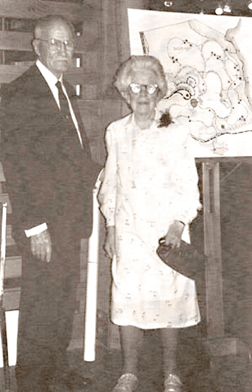 |
The 30 acres in Solomons donated by Francis Koenig in honor of his wife, Ann Marie Koenig, became Annmarie Garden, a world-class sculpture garden. |
Carved In Stone
Chesapeake Country has its own honor legion in stone. At Anne Arundel Medical Center, the Sajak name — famous from television’s Wheel of Fortune — is engraved on a big building on the hospital’s new Parole Campus. Lesly Sajak, wife of game-show host Pat, is a native Marylander. The Rebecca M. Clatanoff Pavilion, where babies come into the world, memorializes another local philanthropist. This year, Annapolis resident Judy Zazulia-Wahl has donated a second $1 million gift to the medical center.
Philanthropy can preserve as well as build.
Francis Koenig donated 30 acres in Solomon’s Island to be developed not as a shopping center or subdivision but as a sculpture park. Named after his wife, Ann Marie Koenig, the donation was a way for Koenig, an architect, to give back to an area he loved. Annmarie Garden is a world-class sculpture garden and tribute to its benefactor’s generosity. As Fran said, “Everything I have built in my life will someday be taken down. Annmarie Garden will always remain.”
Jefferson-Patterson Park and Museum owes its existence to the generosity of another grateful property owner. In 1983, Mary ‘Marvin’ Jefferson Patterson — photojournalist, filmmaker and widow of diplomat Jefferson Patterson — donated their beloved home, Point Farm on its 512 acres, to Maryland. True to Patterson’s love of agriculture and history, the park continues as a working farm and home to a history and archaeology museum and the Maryland Archaeology Conservation Laboratory.
 |
Mary ‘Marvin’ Jefferson Patterson donated her 512-acre Point Farm to Maryland in honor of her husband, diplomat Jefferson Patterson. The park bearing his name continues as a working farm and home to a history and archaeology museum and the Maryland Archaeology Conservation Laboratory. |
The Heart of Main Street
Big givers enrich our communities, and Main Street runs through their hearts. Their giving is part of everyday business. Even as the stumbling economy stubs their bottom lines, Bay Country businesses continue to support their communities.
“Donating is good business,” says Karen Shields, owner of Twin Shields golf course, who with her sister Diane Shields, continues the tradition — both business and giving — begun by her father Roy. “Giving also makes me feel good.”
As business owners, the Shields generously support their Calvert community.
“Twin Shields is almost always helping one cause or another,” says Diane. “I can’t tell you how many green fees and cart gift certificates we give away each year.”
As individuals, Diane and Karen also walk in their father’s footsteps.
Diane, who lives in Annapolis, serves on the Board of Directors of Annapolis Area Ministries as the representative from Calvary United Methodist Church. The Ministries administer the Light House Shelter, as well as Anchor House and Willow House, all providing shelter and services to the homeless in Annapolis.
In 2003 the Calvert County Chamber of Commerce awarded Karen the John C. Smith Public Service Award. In 2001, Karen and her husband, Kenny Keen, were king and queen of the United Way of Calvert County annual Mardi Gras, titles bestowed for raising thousands of dollars for the charity.
Seven years later, that same crown added pizzazz to courtroom attire for Prince Frederick attorney Mark Davis. Davis and his wife, Wanda, were crowned 2008 Mardi Gras king and queen.
“Mark and Wanda Davis did an awesome job raising money,” says United Way’s Jennifer Moreland.
“We do it because the community has been supportive of our firm, and it is one way we can give back,” says Mark. “Giving helps us stay connected with the community.”
Davis’ law firm — Davis, Upton, Palumbo & Keffler LLC — understands the value of a good education. They are big supporters of Calvert County schools. The firm purchased a scoreboard for Huntingtown High School and buys stadium signs and ad space in public school yearbooks.
Community giving is also part of Heather and Darren Maertens’ business. The owners of the Solomon’s jewelry boutique have crafted a unique way of supporting local charities: specially designed jewelry.
“Our Sand Dollar collection raised money for Relay for Life,” says Heather Maerten, “And the sailboat piece supported Arc of Southern Maryland.”
The jeweler’s newest piece is the Brem Butterfly. A percentage of sales will go to the Brem Foundation to Defeat Breast Cancer.
 |
Carroll H. Hynson Sr., “rarely received the accolades he deserved,” said his son Carroll Jr., who started a foundation in his father’s honor. |
“We try to find unusual ways to give back to the community,” says Heather. “It’s fun to make a piece with a specific organization in mind. It makes that piece even more special, and the people who buy the piece are also supporting the cause. Even in this economy, we try to make giving a priority.”
Main Street Anne Arundel
Ray Greenstreet’s primary job is running his Lothian garden center and greenhouses, where thousands of poinsettias, nurtured from cuttings, are now coloring for Christmas. Charitable giving keeps him almost as busy as those poinsettias.
Working with his wife Stacy Greenstreet and the nursery staff, Greenstreet, reaches out with his talents to not only beautify the community he loves but also to motivate young people.
“We work with local school student programs, hoping to get kids interested in agriculture,” he says. “I like to say we’re planting the seed, letting kids know there is more out there than computers.”
The new Deale traffic circle blossoms from this gift: twice a year, Greenstreet donates plants and labor, turning traffic control from an eyesore into a scenic garden.
“Our philosophy is what goes around comes around,” Greenstreet says. “Instead of giving to the many national groups, we like to keep it in the community.”
Giving is good PR, as Carroll Hynson Jr. ought to know. He is president of Image Power Inc. — as well as head of a charitable foundation. The two-year-old Carroll H. Hynson Foundation celebrates his father, who, Hynson said, “rarely received the accolades he deserved” for storefront generosity to his community.
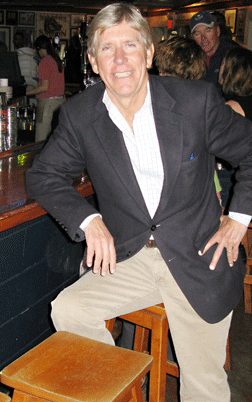 |
“So much of our economic development is based on a healthy Bay,” says Dick Franyo, who contributes to Chesapeake Bay Foundation. |
“I know of over 50 homes people would not have had it not been for my father,” Hynson said.
The Hynson Foundation has a single purpose: equipping African American churches with defibrillators. “We have a great amount of senior citizens in our larger churches. Because of the high rate of heart trouble and stroke in African Americans, maybe we can save someone’s life,” Hynson told Bay Weekly.
The first defibrillators went to Hynson’s home church, Asbury United Methodist in Annapolis.
Giving is a pleasure as well as a philosophy for Boatyard Bar and Grill owner Dick Franyo, a former investment banker who subscribes to Pantagonia clothing outfitter Yvon Chouinard’s one percent theory.
“I believe we all should pay an earth tax for the harm we do to the environment,” says Franyo, who says he learned about giving in his first job — with Baltimore investment banker Alex. Brown — from Greatest Generation mentors. “They felt to the core and preached if you gave back, you’d have a better life. We didn’t know anything else, so we went okay.”
Now Franyo contributes his one percent to the Chesapeake Bay Foundation. But Boatyard Bar and Grill’s door is also open to other causes, including the National Sailing Hall of Fame, of which he’s president.
“So much of our economic development around Anne Arundel County is based on a healthy Bay,” Franyo says. “It’s an important part of doing business, and as a Bay place, we should give back to the Bay.”
Helping Hands
Success, Franyo’s mentors taught, makes giving an obligation. But you don’t have to have millions to give your one percent — and more. One of those regular folk is Edna Deuchler. In her small Pasadena kitchen, Deuchler bakes brownies for 20 people she will know for only one week.
“There’s more I could be doing,” says the 91-year-old Pasadena grandmother, who packs sweet treats and the occasional meal to feed homeless Marylanders staying at Magothy United Methodist Church.
“We have the homeless people [in the church] when it gets cold. They sleep in a big auditorium for a week,” Deuchler says. “Mostly men, but last year there were some husbands and wives, too.”
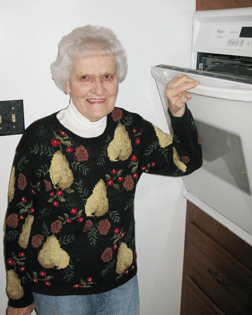 |
At 91, Edna Deuchler bakes brownies for the homeless who stay at her church when it gets cold. |
The church asks parishioners to bring in meals and fruits for the weeklong residents, but Deuchler has her own priorities for food.
“See, they have things like fruit out there on the table that they can eat at all times,” Deuchler says. “But it’s nice to have cookies and things for them, too. We all like desserts.” Along with food, Deuchler gives her time.
“Some of them stay there all day — they don’t have anywhere else to go,” she says. “Sometimes we just go up in the evenings and talk to them. You just talk to them and try to help them.”
Deuchler isn’t the only volunteer who proves age is no excuse to opt out.
“My mother instilled in me good morals, and that’s what I try to do here,” says Boys and Girls Club of Annapolis foster grandmother Callie Johnson. The 95-year-old former assistant music teacher works in the library, offering homework help and advice to first through eighth graders.
“I volunteer because I’m a people person and I love children,” says Johnson. “Some of them call me Grandma Callie. These children here get a lot of love from the staff.”
Along with homework advice, Grandma Callie tries to hone the etiquette skills of her pupils.
“The little kids, when I’m talking to them, they say mhmm or uuh huh [instead of yes or no],” Johnson says. “I tell them to talk. I say even animals talk, even a cow can say moo.” Grandma Callie’s young charges have no complaints, since completed homework earns sweet rewards.
“If they do their homework, I’ll give them bubble gum or fruity things.”
An older generation was responsible for Cathy Lugo’s weekly service.
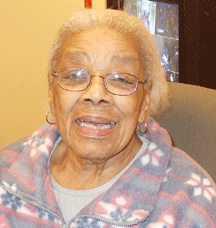 |
“My mother instilled in me good morals, and that’s what I try to do here,” says 95-year-old Callie Johnson, who volunteers with Boys and Girls Club of Annapolis, offering homework help and advice to first through eighth graders. |
“My mother has been serving and delivering meals in Ohio for 27 years,” says the 57-year-old Annapolitan, who packs food weekday mornings for Meals on Wheels. “I would come along and help. The joy in the faces of the elderly: Sometimes you’re the only person they see all day.”
Lugo makes her Thanksgiving service a family affair. “Two years ago,” she says, “I brought my husband and daughter, because it’s hard to get volunteers to come in on the holidays. This year, three of us from the Lugo family will be packing on Thanksgiving day. Then we come home and have our own meal.
“It’s a marvelous way to feel connected to the community, it’s a marvelous way to help others,” says Lugo of her two and a half years of service. “And when the job’s done, you’re done: There’s no homework.”
Just as you’re never too old to volunteer, you’re never too young, either.
Annapolitans Tony and Penny Evans, the Community Foundation’s Volunteers of the year, are past retirement age. But they started young: as soon as Tony was old enough to drive, he signed up with the New Hope, Pennsylvania, volunteer fire department. Penny found time to volunteer even with a young family. Education, arts, politics, local government and food — Tony retired from Maryland Department of Agriculture — are their chief causes.
For Maryland Hall for the Creative Arts, Penny does heroic service. The volunteer chief of staff for Arts Alive, she brings in all the arts donations for the silent and live auction, manages a cocktail party, seated dinner and wine raffle — all after setting up and decorating six or seven interlocking tents.
This week, they’ll be serving Thanksgiving dinner for We Care.
“Anything that needs doing,” Tony says. He’s not kidding. He even helped Bay Weekly move last year.
“We just like being busy,” Tony says. But beyond the fun, we’re putting something back into a community that’s been very good to us. It’s like a bank. People who need make withdrawals, and people who can make deposits.
“We don’t have lot of money,” he says, “so we substitute labor and talent for money.”
College students fit the same pattern: short on cash, long on talent and time.
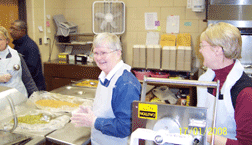 |
Cathy Lugo and her mother pack food for Meals on Wheels. “This year, three of us from the Lugo family will be packing on Thanksgiving day,” she said. |
Nicole Morgan a 19-year-old college student, just got her first taste of volunteering.
“One of my classes requires that I give 15 hours of volunteer work,” Morgan explains. “I chose United Way of Calvert County.”
Morgan, who lives in Owings, spent her volunteer hours helping set up for a conference and providing much needed office help in the United Way’s office.
“I set up chairs and help lay out food at the Barstow Acres Empowerment Conference,” Morgan says. “I also helped with direct mailings, stuck stickers on pamphlets for their Mardi Gras event and worked on their database.”
Morgan has caught the volunteering bug.
“I definitely plan to go back and help United Way,” she says. “I really want to get out into the community and do what I can to help.”
Creature Comforts
Animal rescue organizations are often all volunteer. For some, the gratification of working with needy animals becomes their life work.
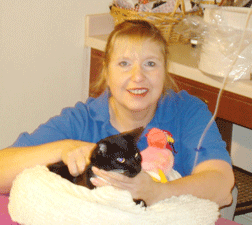 |
In 2004, Katherine Rude left her government job to found Rude Ranch Animal Rescue in Harwood. “It seemed like there was so much need,” she said. |
Like Katherine Rude, co-founder of Harwood’s Rude Ranch Animal Rescue.
“It seemed like there was so much need,” Rude says. “Animals running out in the road, looking for food, living behind restaurants and making more animals. There weren’t a whole lot of options for them.”
Rude and husband Bob Rude started rescuing cats in 1997. They began with TNR — trap, neuter and release — behind a restaurant in Crofton.
“It’s just kind of grown from there,” says Rude, who left her job as a government database administrator in 2004 to devote herself full-time to animal rescue. “In addition to being no-kill, we are also cage-less. Once we make sure the animals are healthy, they can run and play.”
Even sick cats get a space at the expanded ranch — a former Hari Krishna temple.
“There’s several rooms of special needs animals that have been abused or are terrified of people. We have a section for cats with feline leukemia and feline immunodeficiency virus,” Rude says.
In addition to 118 felines, the ranch houses six dogs and anything else the Rudes can rescue.
“We branched into search and rescue, disaster aid,” says Rude. “We are the Maryland state disaster emergency transportation. We last were deployed on the Iowa flooding. We did day-to-day care for animals pulled out of the water until their people came.”
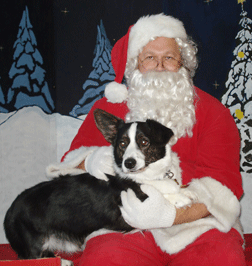 |
During the Christmas season, Bob Rude dons a beard and a red suit to become Santa Paws, offering his picture with people’s pets to raise money for Rude Ranch Animal Rescue. |
This holiday season, Bob Rude continues the Ranch’s tradition of Christmas cheer as a Santa Paws, posing with pets for pictures to raise money for the charity.
At Calvert County Humane Society, another no-kill shelter, “we’d have nothing without our volunteers,” says volunteer president Kelly St. Marie. “They keep us going. Volunteers come in to play with the dogs, walk them, take them for rides, to events to be seen, so they can be socialized and meet people and find their forever homes.”
Help for the creatures who share our planet is not just given to the warm, fuzzy species. Chesapeake Country philanthropists are helping to restore habitat for their underwater neighbors.
Jack and Susan Power of Holland Point have given big to help create a healthy marine environment in the Jackspot, a fishing area off Ocean City.
“My boat is in Ocean City,” Jack Power told Bay Weekly. “That’s how we learned about the Ocean City Reef Foundation and the New York City subway car project.”
The Powers pledged $50,000.
“We purchased a barge of 48 subway cars,” Jack says. “The cars were free, but we had to pay for the barge and crew to bring them down from New York.”
The Susan J. Power reef, named for its benefactor, is already attracting new residents.
“We are so enthralled by the success of the project that we’ve made a commitment for a second barge next year,” Power says. The second reef will be named for their daughter, Lindsey, who now lives in New York City, which makes their commitment to the reef project even more personal: Lindsey rides the New York subway.
“It is the most generous thing we’ve ever done,” Power says. “We knew we could directly and immediately make positive difference.”
Mini Rockefellers
Big gifts are not so rare as you might imagine. Philanthropy is one of the things you may not know about your neighbors — because they don’t want their names carved in stone — or even inked in newsprint.
One family bookkeeper saves for giving by rounding up each checkbook entry so at year’s end there is a nice balance in the bank to account for an anonymous donation. Another family has designated several scholarships as beneficiaries in their wills. Their gift won’t be enough to get their names drilled into any buildings, but they hope their lifetime of savings will buy someone a college education.
 |
Jack and Susan Power purchased a barge of 48 New York City subway cars to create the Susan J. Power reef, an underwater refuge for fish in Chesapeake Bay. |
An Annapolitan neighbor calls Bay Weekly every year as tax time approaches, asking us to remind readers of a certain age — 701⁄2 — and income that the Required Minimum Distribution on their IRAs may give them a charitable opportunity — and save on their tax bill. His Required Minimum Distribution is large enough — thanks to lucky early investments — that each year he gives $20,000 in four $5,000 installments to charities, usually environmental.
Consider yourself reminded.
Anna Greenberg is renowned for her philanthropy in Anne Arundel County and beyond. But she, too, wants no more publicity.
“I don’t want any more honors,” says the winner of the 2007 Community Foundation of Anne Arundel County’s Philanthropist of the Year award. Her reward is in the giving. “Philanthropy is the rent I pay for my time here on earth,” she says.
A perennial giver, Greenberg — the daughter of the owner of a segregated Annapolis movie theater — is named on the letterhead of nearly every Annapolis arts organization.
“She donates her time to everyone. That’s a precious commodity. Nonprofits think in terms of more than money: time, leadership, skill,” says Linnell Bowen, executive director of Maryland Hall for the Creative Arts.
“I serve not only in Annapolis but on many national boards,” Greenberg says. “I try not to say no. But I’ve had to turn down some as I’m getting older. The travel is exhausting and the cost tremendous — as on boards you’re expected to produce. You either give, get or get off.”
| How to Help
In Anne Arundel County, the footwork’s done for you. The Volunteer Center for Anne Arundel County “connects people who want to volunteer with needs of the county,” says executive director Fay Mauro. “We work with more than 330 agencies year-round. During the holidays, we emphasize giving the gift of time and service. We have a holiday guide on our website listing more than 40 agencies in Anne Arundel County and their volunteer and donation needs through early January”: www.volunteerannearundel.org. In Calvert County, two guides help you find your way to volunteer. The United Way of Calvert County link is www.unitedwaycalvert.org/volunteer.htm. The College of Southern Maryland also runs a database of volunteer opportunities: www.csmd.edu/vsmd/aboutus/. |
With Gratitude
The generosity in our communities is extraordinary. As much as we wanted to write about each and every good soul, there simply isn’t enough space in the paper.
We have learned of the anonymous donors who contribute their time and money, but do so quietly.
So many of our Main Street businesses — including many of our advertisers — give generously, we couldn’t list them all, but we appreciate all they do. Like Don Riddle of Homestead Gardens, Fred Graul of Graul’s Market, Bruce Chance of W.R. Chance Jewelers, Gordon and Grace Bowen of Bowen’s Market and Gary and Jen Armstrong of Heavenly Chicken and Ribs in Dunkirk, just to mention a few.
Then there are all of our neighbors who, by simple acts, help improve many lives. They drop not one, but several cans of food in food pantry collection bins. One family sends a case of doggie biscuits each Christmas to their local animal shelter. They give over their weekends, year-round, to building new homes for those without, or helping repair the homes of those who cannot. And Bay Weekly’s own Bay Gardener, Dr. Frank Gouin who, with fellow Ruritan Don Arthur and with the club’s contribution, bought and delivered $1,000 worth of food to the Lothian food bank, SCAN, just last week.
Which brings us to the many groups we didn’t mention whose mission it is to make their communities a better place to live: Rotarians, Ruritans, Boy Scouts, Girl Scouts, church groups, hospice volunteers, Red Cross volunteers, the Chamber of Commerce …
The list never ends.
In difficult times — food pantries tell us need has doubled just this year — charitable giving becomes even more important. And we are stepping up to the plate, even as our bank accounts shrink.
Jennifer Moreland of the United Way of Calvert County may have said it best: “I think gloomy news brings out the philanthropic nature in people. They find doing things for others gives them something to feel good about.”